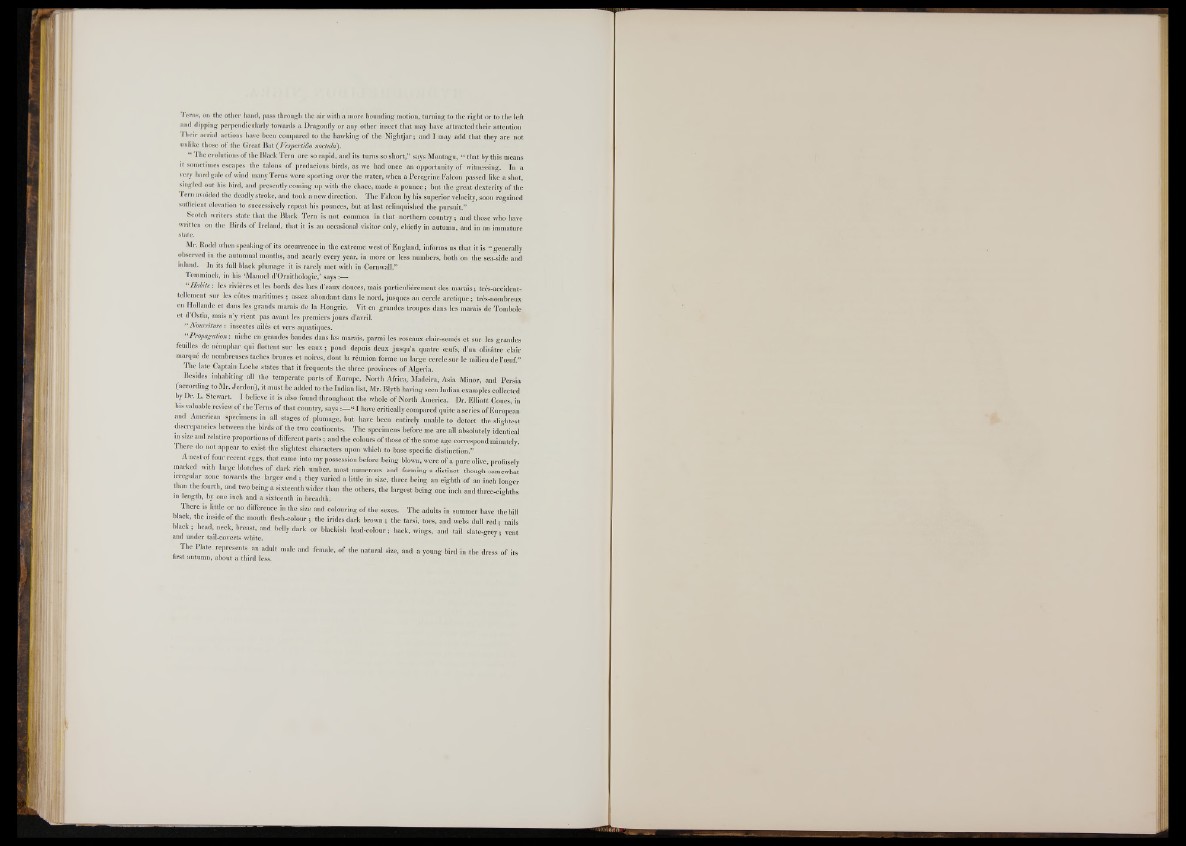
Terns, on the other hand, pass through the air with a more bounding motion, turning to the right or to the left
and (lipping perpendicularly towards a Dragonfly or any other insect that may have attracted their attention
Their aerial actions have been compared to the hawking o f the Nightjar; and I may add that they are not
unlike those o f the Great Bat ( Vespertilio noctuld).
“ The evolutions of the Black Tern are so rapid, and its turns so short,” says Montagu, “ that by this means
it sometimes escapes the talons o f predacious birds, as we had once an opportunity o f witnessing. In a
very hard gale o f wind many Terns were sporting over the water, when a Peregrine Falcon passed like a shot,
singled out his bird, and presently coming up with the chace, made a pounce ; but the great dexterity o f the
Tern avoided the deadly stroke, and took a new direction. The Falcon by his superior velocity, soon regained
sufficient elevation to successively repeat his pounces, but at last relinquished the pursuit.” .
Scotch writers state that the Black Tern is not common in that northern country ; and those who have
written on the Birds o f Ireland, that it is an occasional visitor only, chiefly in autumn, and in an immature
state.
Mr. Rodd when speaking o f its occurrence in the extreme west o f England, informs us that it is “ generally
observed in the autumnal months, and nearly every year, in more or less numbers, both 011 the sea-side and
inland. In its full black plumage it is rarely met with in Cornwall.”
Temminck, in his ‘Manuel d’Ornithologie,’ says :—
“Habite: les rivières et les bords des lacs d’eaux douces,mais particulièrement des marais; très-accident-
tellement sur les cotes maritimes ; assez abondant dans le nord, jusques au cercle arctique ; très-nombreux
en Hollande et dans les grands marais de la Hongrie. Vit en grandes troupes dans les marais de Tombole
et d’Ostia, mais n’y vient pas avant les premiers jours d’avril.
“ Nourriture : insectes ailés et vers aquatiques.
“Propagation: niche en grandes bandes dans les marais, parmi les roseaux clair-semés et sur les grandes
feuilles de nénuphar qui flottent sur les eaux ; pond depuis deux jusqu’a quatre oeufs, d’un olivâtre clair
marqué de nombreuses taches brunes et noires, dont la réuuion forme un large cercle sur le milieu de l’oeuf.”
The late Captain Loche states that it frequents the three provinces o f Algeria.
Besides inhabiting all the temperate parts o f Europe, North Africa, Madeira, Asia Minor, and Persia
(according to Mr. Jerdon), it must be added to the Indian list, Mr. Blyth having seen Indian examples collected
by Dr. L. Stewart. I believe it is also found throughout the whole o f North America. Dr. Elliott Coues, in
his valuable review o f the Terns of that country, says “ I have critically compared quite a series o f European
and American specimens in all stages o f plumage, but have been entirely unable to detect the slightest
discrepancies between the birds o f the two continents. The specimens before me are all absolutely identical
in size and relative proportions o f different parts ; and the colours o f those o f the same age correspond minutely.
There do not appear to exist the slightest characters upon which to base specific distinction.”
A nest o f four recent eggs, that came into my possession before being blown, were o f a pure olive, profusely
marked with large blotches o f dark rich umber, most numerous and forming a distinct though somewhat
irregular zone towards the larger end ; they varied a little in size, three being an eighth o f an inch longer
than the fourth, and two being a sixteenth wider than the others, the largest being one inch and three-eighths
111 length, by one inch and a sixteenth in breadth.
There is little or no difference in the size and colouring of the sexes. The adults in summer have the bill
b ack, the mstdeofthe month flesh-colour ; the iridesdark brown ; the tarsi, toes, and webs dull red: nails
black ; head, neck, breast, and belly dark or blackish lead-colour ; back, wings, and tail slate-grey vent
and under tail-coverts white.
The Plate represents an adult male and female, of the natural size, and a young bird in the dress o f its
first autumn, about a third less.